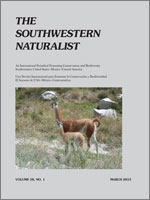We analyzed composition and structure of a bottomland forest in north-central Texas that was a form of the sugarberry-cedar elm-pecan (Celtis laevigata variety laevigata-Ulmus crassifolia-Carya illinoinensis) forest, which is widespread in south-central North America. The forest had three layers: upper canopy of dominant trees, under canopy of shorter trees and shrubs, and herbaceous zone of native C3 grasses with annual and perennial forbs. Sugarberry and cedar elm were dominant trees with greatest density and regeneration in advanced successional stages, whereas pecan was established in earlier seral stages and persisted as a dominant with largest individual trees and less regeneration. Other important native species of trees included red mulberry (Morus rubra) and bois d'arc (Maclura pomifera). Canada wildrye (Elymus canadensis) and broadleaf woodoats (Chasmanthium latifolium) were dominants of the herbaceous layer. The most common forbs were giant ragweed (Ambrosia trifida variety texana) and pigeonberry (Rivina humilis). Peak standing crop of herbage was 1,597 kg/ha.
Se analizaron la composición y estructura de un bosque de tierras bajas en el norte-centro de Texas que era una forma del bosque de Celtis laevigata variedad laevigata-Ulmus crassifolia-Carya illinoinensis que está muy extendido en el centro-sur de Norteamérica. El bosque tiene tres capas: dosel superior de los árboles dominantes, dosel inferior de los árboles más bajos y arbustos, y zona herbácea de pastos nativos C3 con hierbas anuales y perennes. Celtis l. laevigata y U. crassifolia fueron árboles dominantes con mayor densidad y regeneración en etapas avanzadas de sucesión, mientras que C. illinoinensis se estableció en las primeras etapas seriales y persistió como dominante con árboles individuales más grandes y menos regeneración. Otras especies nativas importantes incluyeron morera rojo (Morus rubra) y naranjo de Luisiana (Maclura pomifera). Elimo canadiense (Elymus canadensis) y de verdolaga hoja ancha (Chasmanthium latifolium) fueron dominantes en el estrato herbáceo. Las hierbas más comunes eran ambrosía (Ambrosia trifida variedad texana) y coralillo (Rivina humilis). El pico de la biomasa vegetal fue 1,597 kg/ha.





